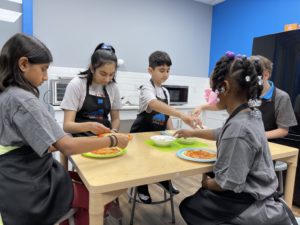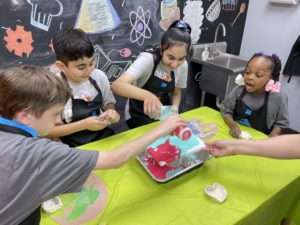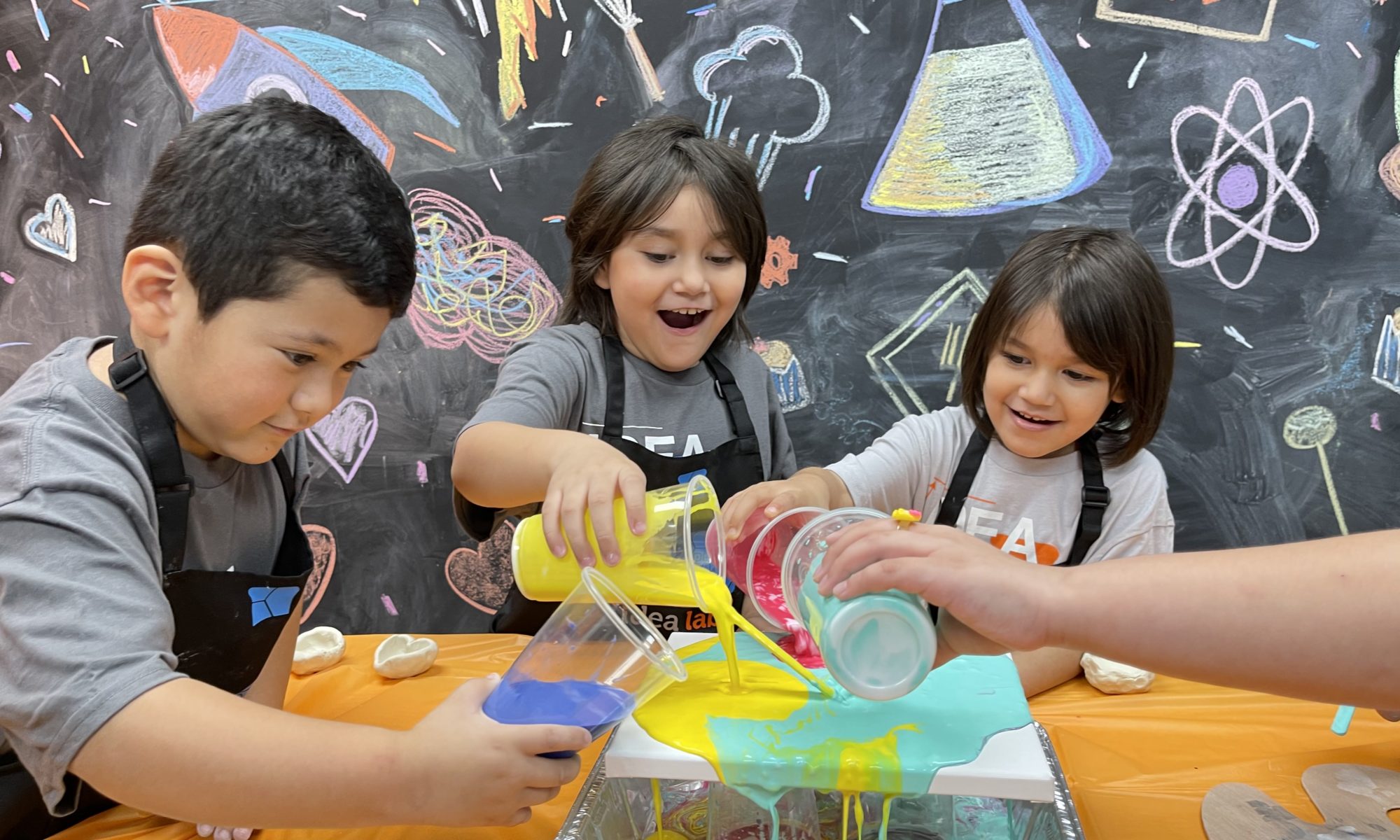Your child doesn’t have to be a Baby Einstein or the next Neil deGrasse Tyson to benefit from a STEAM education. And if they’re naturally drawn to science, there are huge benefits to ensuring that art is part of their education, too.
Besides generating better test scores, an improved sense of well-being, and lots of fun, a well-rounded STEAM education can help children succeed in both school and real life by combining the scientific method with the creative process.
How does one simple philosophy accomplish so much?
The interdisciplinary STEAM approach simultaneously develops a variety of skills in project-based learning episodes: critical thinking, innovative problem-solving, communication, and technological literacy are often all required in order to achieve the lesson’s goal.
Here’s a quick-and-dirty explanation of how STEAM develops each of these skills and why they’re important for kids:
 Critical thinking is the ability to analyze facts and draw conclusions. At a basic level, this could mean understanding that backtalking (a cause) results in losing television privileges (an effect). At higher levels, it involves more skillful deduction and educated guessing.
In STEAM education, critical thinking is central to every lesson. The scientific method can introduce children to simple cause-and-effect relationships, but it can also demonstrate more complicated chains of reaction. An artistic approach may also teach students that mixing yellow and blue creates green, eventually empowering them to mix more nuanced shades through experimentation.
Critical thinking skills are a huge benefit. They help children produce better test scores, and they may even help them maintain interest in learning materials. Beyond the classroom, critical thinking also enables kids (and adults) to screen for biases in the media they consume. It also improves productivity in analytical activities such as reading medical charts and maintaining personal finances.
Critical thinking is the ability to analyze facts and draw conclusions. At a basic level, this could mean understanding that backtalking (a cause) results in losing television privileges (an effect). At higher levels, it involves more skillful deduction and educated guessing.
In STEAM education, critical thinking is central to every lesson. The scientific method can introduce children to simple cause-and-effect relationships, but it can also demonstrate more complicated chains of reaction. An artistic approach may also teach students that mixing yellow and blue creates green, eventually empowering them to mix more nuanced shades through experimentation.
Critical thinking skills are a huge benefit. They help children produce better test scores, and they may even help them maintain interest in learning materials. Beyond the classroom, critical thinking also enables kids (and adults) to screen for biases in the media they consume. It also improves productivity in analytical activities such as reading medical charts and maintaining personal finances.
Problem-Solving
Problem-solving requires both critical thinking and creativity. To solve new problems, a child must be able to invent equally new solutions.
STEAM lessons require innovative problem-solving in variety of ways. Artistic prompts are often open-ended and can be interpreted broadly, encouraging students to think creatively. Even science projects require a healthy amount of creativity—for example, what are the optimal conditions for growing a sunflower? Students must decide what variables to manipulate (water, sunlight, fertilizer, singing to the plant…) and by how much in order to answer their scientific questions.
Problem-solving skills will carry kids far both in school and beyond. They can help students figure out questions on the state tests that they didn’t quite cover in class or win them a prize at the school science fair. Problem-solving is also at the root of modern entrepreneurship and many tech companies that seek to streamline everyday tasks or solve emerging issues.
 Effective communicators simplify big ideas into chunks that are easy to understand. Sure, there are rules of grammar and spelling—but ease of understanding is equally important. Good communication may also include persuasion, emotion, and building trust, especially in leadership roles.
Because STEAM learning is often project-based, students often work in groups. This requires division of tasks and integration of many different ideas. Kids learn how to negotiate for the roles that they want, resolve conflicts, and present results to the class. Communication is a powerful exercise in collaboration with extraordinary results.
Good communication skills look very similar across all stages of life and across all industries. Whether writing a college admissions essay, pitching a sale to a potential client, or delivering a keynote speech at a conference, effective communication is a vital step to achieving meaningful goals. Even parenting requires a daily communication workout!
Effective communicators simplify big ideas into chunks that are easy to understand. Sure, there are rules of grammar and spelling—but ease of understanding is equally important. Good communication may also include persuasion, emotion, and building trust, especially in leadership roles.
Because STEAM learning is often project-based, students often work in groups. This requires division of tasks and integration of many different ideas. Kids learn how to negotiate for the roles that they want, resolve conflicts, and present results to the class. Communication is a powerful exercise in collaboration with extraordinary results.
Good communication skills look very similar across all stages of life and across all industries. Whether writing a college admissions essay, pitching a sale to a potential client, or delivering a keynote speech at a conference, effective communication is a vital step to achieving meaningful goals. Even parenting requires a daily communication workout!
 Personal computers, the internet, smartphones, QR codes—these are technological marvels that are now integrated into the average person’s daily life. Whether you and your child are early-adopters or technophobes, it’s clear that a certain level of skill with technology is essential to modern living. And depending on your occupation, you may deal with even more complicated technology on a daily basis!
STEAM cultivates the adaptive skills required to learn new technology. While your child learns how to use GPS and humidity sensors during science fieldwork, they’re building the neural pathways that will help them quickly learn Photoshop or GarageBand. They’ll process data in Google Sheets and design posters to present their results in Canva.
Each new technological skill prepares students for life outside of school. While your child may complain, “But when will I actually use geometry in real life?” you know that they will definitely use high-tech tools or computer software every day in their adult life.
Personal computers, the internet, smartphones, QR codes—these are technological marvels that are now integrated into the average person’s daily life. Whether you and your child are early-adopters or technophobes, it’s clear that a certain level of skill with technology is essential to modern living. And depending on your occupation, you may deal with even more complicated technology on a daily basis!
STEAM cultivates the adaptive skills required to learn new technology. While your child learns how to use GPS and humidity sensors during science fieldwork, they’re building the neural pathways that will help them quickly learn Photoshop or GarageBand. They’ll process data in Google Sheets and design posters to present their results in Canva.
Each new technological skill prepares students for life outside of school. While your child may complain, “But when will I actually use geometry in real life?” you know that they will definitely use high-tech tools or computer software every day in their adult life.
Critical Thinking
 Critical thinking is the ability to analyze facts and draw conclusions. At a basic level, this could mean understanding that backtalking (a cause) results in losing television privileges (an effect). At higher levels, it involves more skillful deduction and educated guessing.
In STEAM education, critical thinking is central to every lesson. The scientific method can introduce children to simple cause-and-effect relationships, but it can also demonstrate more complicated chains of reaction. An artistic approach may also teach students that mixing yellow and blue creates green, eventually empowering them to mix more nuanced shades through experimentation.
Critical thinking skills are a huge benefit. They help children produce better test scores, and they may even help them maintain interest in learning materials. Beyond the classroom, critical thinking also enables kids (and adults) to screen for biases in the media they consume. It also improves productivity in analytical activities such as reading medical charts and maintaining personal finances.
Critical thinking is the ability to analyze facts and draw conclusions. At a basic level, this could mean understanding that backtalking (a cause) results in losing television privileges (an effect). At higher levels, it involves more skillful deduction and educated guessing.
In STEAM education, critical thinking is central to every lesson. The scientific method can introduce children to simple cause-and-effect relationships, but it can also demonstrate more complicated chains of reaction. An artistic approach may also teach students that mixing yellow and blue creates green, eventually empowering them to mix more nuanced shades through experimentation.
Critical thinking skills are a huge benefit. They help children produce better test scores, and they may even help them maintain interest in learning materials. Beyond the classroom, critical thinking also enables kids (and adults) to screen for biases in the media they consume. It also improves productivity in analytical activities such as reading medical charts and maintaining personal finances.
Problem-Solving
Problem-solving requires both critical thinking and creativity. To solve new problems, a child must be able to invent equally new solutions.
STEAM lessons require innovative problem-solving in variety of ways. Artistic prompts are often open-ended and can be interpreted broadly, encouraging students to think creatively. Even science projects require a healthy amount of creativity—for example, what are the optimal conditions for growing a sunflower? Students must decide what variables to manipulate (water, sunlight, fertilizer, singing to the plant…) and by how much in order to answer their scientific questions.
Problem-solving skills will carry kids far both in school and beyond. They can help students figure out questions on the state tests that they didn’t quite cover in class or win them a prize at the school science fair. Problem-solving is also at the root of modern entrepreneurship and many tech companies that seek to streamline everyday tasks or solve emerging issues.
Communication
 Effective communicators simplify big ideas into chunks that are easy to understand. Sure, there are rules of grammar and spelling—but ease of understanding is equally important. Good communication may also include persuasion, emotion, and building trust, especially in leadership roles.
Because STEAM learning is often project-based, students often work in groups. This requires division of tasks and integration of many different ideas. Kids learn how to negotiate for the roles that they want, resolve conflicts, and present results to the class. Communication is a powerful exercise in collaboration with extraordinary results.
Good communication skills look very similar across all stages of life and across all industries. Whether writing a college admissions essay, pitching a sale to a potential client, or delivering a keynote speech at a conference, effective communication is a vital step to achieving meaningful goals. Even parenting requires a daily communication workout!
Effective communicators simplify big ideas into chunks that are easy to understand. Sure, there are rules of grammar and spelling—but ease of understanding is equally important. Good communication may also include persuasion, emotion, and building trust, especially in leadership roles.
Because STEAM learning is often project-based, students often work in groups. This requires division of tasks and integration of many different ideas. Kids learn how to negotiate for the roles that they want, resolve conflicts, and present results to the class. Communication is a powerful exercise in collaboration with extraordinary results.
Good communication skills look very similar across all stages of life and across all industries. Whether writing a college admissions essay, pitching a sale to a potential client, or delivering a keynote speech at a conference, effective communication is a vital step to achieving meaningful goals. Even parenting requires a daily communication workout!
Technological Literacy
 Personal computers, the internet, smartphones, QR codes—these are technological marvels that are now integrated into the average person’s daily life. Whether you and your child are early-adopters or technophobes, it’s clear that a certain level of skill with technology is essential to modern living. And depending on your occupation, you may deal with even more complicated technology on a daily basis!
STEAM cultivates the adaptive skills required to learn new technology. While your child learns how to use GPS and humidity sensors during science fieldwork, they’re building the neural pathways that will help them quickly learn Photoshop or GarageBand. They’ll process data in Google Sheets and design posters to present their results in Canva.
Each new technological skill prepares students for life outside of school. While your child may complain, “But when will I actually use geometry in real life?” you know that they will definitely use high-tech tools or computer software every day in their adult life.
Personal computers, the internet, smartphones, QR codes—these are technological marvels that are now integrated into the average person’s daily life. Whether you and your child are early-adopters or technophobes, it’s clear that a certain level of skill with technology is essential to modern living. And depending on your occupation, you may deal with even more complicated technology on a daily basis!
STEAM cultivates the adaptive skills required to learn new technology. While your child learns how to use GPS and humidity sensors during science fieldwork, they’re building the neural pathways that will help them quickly learn Photoshop or GarageBand. They’ll process data in Google Sheets and design posters to present their results in Canva.
Each new technological skill prepares students for life outside of school. While your child may complain, “But when will I actually use geometry in real life?” you know that they will definitely use high-tech tools or computer software every day in their adult life.



